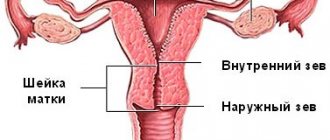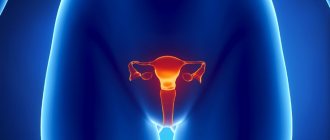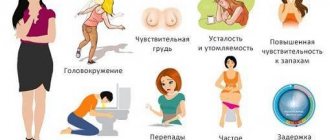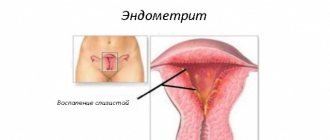≡ Home → Tumor diseases of the uterus → Cervical cyst →
A cervical cyst is a pathology that occurs against the background of inflammatory processes or hormonal changes. It is formed mainly during reproductive age. It is characterized by an asymptomatic course, but can lead to the appearance of pathological discharge from the vagina. It is detected during a gynecological examination. The diagnosis is confirmed by colposcopy with biopsy.
Cauterization of cervical cysts is one of the effective methods of treating pathology. After removal of the lesion, the mucous membrane of the organ is restored within 3-6 weeks. Various techniques are used for cauterization, and each of them has its own indications and limitations. Let's take a closer look at how a cervical cyst is removed, and what methods are suitable for women planning a pregnancy.
Briefly about pathology
There are various formations on the cervix - polyps, erosions, cysts. The latter differ in their structure. Essentially, it is a bubble with liquid inside. Often a capsule is formed in a gland, the duct of which for some reason is closed, as a result of which the secretion produced accumulates in it. Such formations are called retention. Outwardly, it looks like one or several pimples from a couple of mm to 2-3 cm in diameter.
.gif' data-lazy-type='image' data-src='https://parnas42.ru/wp-content/uploads/2019/08/smkwhj2x.jpg' alt='01' width='626′ height ='303′ » data-'https://parnas42.ru/wp-content/uploads/2018/04/prizhech-.jpg 800w, https://parnas42.ru/wp-content/uploads/2018/04/ prizhech—300×145.jpg 300w, https://parnas42.ru/wp-content/uploads/2018/04/prizhech—768×372.jpg 768w' sizes='(max-width: 626px) 100vw, 626px' >
Causes of cysts
A formation on the cervix is formed due to the following factors:
- Trauma is mechanical damage to the mucous membrane. This can happen during gynecological operations, for example, abortions, curettage. And also during childbirth,
- Infection is an inflammatory process in the uterus and vagina, which is provoked by the proliferation of dangerous microbes and promotes increased secretion production by the glands of the mucous membrane. Which, in turn, causes blockage and cyst formation,
- Menopause – due to natural changes, the risk of retention formation increases.
Reference! Retention cysts on the cervical mucosa are called Nabotov cysts.
Clinical manifestations
There are no characteristic signs of pathology; often the disease does not give any symptoms. The picture is formed with sufficiently large capsules:
- Pulls in the lower abdomen
- Blood appears in the discharge outside of menstruation,
- Your periods become heavy
- Pain during sex.
.gif' data-lazy-type='image' data-src='https://parnas42.ru/wp-content/uploads/2019/08/4kubpvwj.jpg' alt='Nagging pain in the lower abdomen' width=' 565′ height='362′ » data-'https://parnas42.ru/wp-content/uploads/2018/04/shutterstock_590546507.jpg 730w, https://parnas42.ru/wp-content/uploads/2018/ 04/shutterstock_590546507-300×192.jpg 300w' sizes='(max-width: 565px) 100vw, 565px'>
Why do you need to remove the cyst?
A large formation in the cervical area not only causes inconvenience in the form of symptoms of pathology, but can also lead to dangerous consequences:
- Disruption of the uterus and the entire reproductive system. A large formation puts pressure on the organ, which prevents it from functioning normally.
- Tissue abscess, source of infection. The contents of the cyst in most cases turn into pus when pathogenic bacteria enter the capsule.
- Oncology. The cyst itself is not capable of degenerating into a cancerous tumor. But its presence has a detrimental effect on the tissue of the cervix and cervical canal, which can provoke tumor growth in the surrounding areas, if there are other prerequisites for this.
Attention! A cyst is a pathological formation, so it needs treatment, which may include removal surgery.
It is important that there is no drug therapy that can directly remove the capsule. They use medications to get rid of the infection and restore hormonal levels in case of endocrine disorders, but this will not help remove the formation. The only guaranteed way to heal is surgery. The cyst, which is localized on the cervix, is removed by cauterization.
Methods
The procedure for removing cysts using cauterization has several methods. Each patient, taking into account financial capabilities and health status, will choose the appropriate method. Below are six options for carrying out this procedure.
- Contact cauterization with electric current. This is a method of diathermocoagulation in which a cauterization device comes into contact with the affected area and penetrates the affected tissue itself. It has a number of disadvantages, due to which it has recently lost popularity in gynecological practice.
- Cauterization using a microarc. Diathermocoagulation occurs at a distance from the affected area. The current charge in the form of a microarc affects the cyst. The use of electric current helps to completely eliminate the cyst.
- Chemical cauterization. This procedure takes place under anesthesia. The dilator is used to open the cervix and dry it with a cotton swab. Afterwards, the drug “Solkovagin” is applied to the affected area and left for a while. This is a mixture of acids. Afterwards, the tampon is removed and the cervix is wiped with a clean cotton swab.
- Cryotherapy. This is the process of cauterizing a cyst on the cervix with liquid nitrogen. Under the influence of low temperatures, the death of nerve cells and cysts occurs. The drug is applied to the affected area for 5 minutes and applied with cold. After another 5 minutes it cools down. The procedure lasts 10 minutes and is practically painless.
- Laser cauterization is perfect for women who have not yet given birth. However, the main disadvantage is that the operation is painful. The procedure lasts on average half an hour, and the device itself does not touch the cervix.
The advantages of this type:
- no destruction of healthy tissue;
- no bleeding;
- absence of scars and adhesions;
- no inflammatory complications;
- fast recovery period.
- Radio wave cauterization. Mainly occurs with the help of the drug Surgitron. In this operation, an incision is made on the affected gland using a radio wave knife. The liquid is removed by vacuum. No pain. Lasts about 2 seconds. After this method of cauterization, scars do not form. This is the fastest operation in which sex is allowed after two days.
A month after the operation, the doctor conducts a follow-up examination of the area where the cyst was removed. After the operation, medication is prescribed and some recommendations are given.
Indications
Surgical intervention is an optional measure; reasons for its appointment are necessary:
- The cyst is growing rapidly.
- It is large in size and interferes with the normal functioning of organs.
- It is a source of chronic infection.
- Provokes bleeding.
- There are other abnormalities of the mucous membrane, for example, cervical polyps.
Doctor, expert
It happens that with this pathology, against the background of the normal state of the uterus and ovaries, a woman feels bad: her cycle is disrupted, she suffers from pain and other troubles. Then this may be a reason for an operation.
Contraindications to cyst cauterization
Even with visible prerequisites for removal, it is not always possible to do this. There are a number of prohibitions, some are temporary and can be eliminated:
- period of menstruation,
- Endometriosis,
- Venereal diseases,
- Carrying a child and breastfeeding,
- Cancerous tumors of the uterus or ovaries,
- Scar formations on the cervix,
- Myoma,
- Degree 3 mucosal dysplasia, which is the initial stage of oncology.
.gif' data-lazy-type='image' data-src='https://parnas42.ru/wp-content/uploads/2019/08/odogadsz.jpg' alt='Appointment with a gynecologist' width='540 ′ height='360′ » data-'https://parnas42.ru/wp-content/uploads/2018/04/1_289.jpg 768w, https://parnas42.ru/wp-content/uploads/2018/04 /1_289-300×200.jpg 300w' sizes='(max-width: 540px) 100vw, 540px'>
When is cauterization recommended?
Most tumors that appear on the cervix are successfully cured in the initial stages, but the main factor in such cases is to diagnose a cervical cyst in time. Unfortunately, at the beginning of its development the cyst does not show any symptoms, and often it can be diagnosed in the later stages.
The main reason why cauterization is prescribed is the presence of the tumor itself, as well as a number of consequences that negatively affect the reproductive system and the health of women in general.
It is recommended to cauterize the cyst in the following cases:
- In the presence of bacterial damage to the uterine tissue. In such cases, a white and yellow coating can be observed around the tumor, which indicates tissue damage by pathogenic bacteria. Bacteria are formed due to improperly performed surgery on the uterus or lack of proper care in the postoperative period.
- With intense bleeding. Excessive discharge of bloody fluid, similar to menstruation, is direct evidence that the tumor needs to be treated or removed. This is caused by the fact that the cyst reaches an impressive size and begins to put pressure on the tissue of the uterus, exerting a pathogenic effect on the uterus and preventing it from functioning normally.
- Sharp pain in the lower abdomen. It is also recommended to remove a cervical cyst in cases where a woman experiences causeless acute pain in the lower abdomen. As a rule, these pains have nothing to do with the menstrual period, and have an extremely negative effect on the reproductive system due to frequent uterine spasms.
- Pain is felt during sexual intercourse. If acute pain is felt during sexual intercourse, it is recommended to remove the cyst, or, as a last resort, undergo intensive treatment.
- The appearance of pain when urinating. If a woman experiences pain when urinating, this may indicate that the cyst has caused inflammation in the tissues of the cervix.
Preparing for surgery
To remove a cyst, you need to go through 2 stages of preliminary measures.
Diagnostics
Before cauterizing a formation in the cervical area, it is important to ensure the accuracy of the diagnosis, ensure that there are no contraindications and that there are indications for surgical intervention. This can be done through a number of examinations:
- General blood and urine analysis,
- Vaginal smear to determine its flora,
- Bacterial culture in the presence of dangerous microbes to select the necessary antibacterial drug against pathology,
- Cyto and histology of cervical tissue to identify cancer cells,
- Various tests for sexually transmitted diseases,
- Blood for HIV, hepatitis and syphilis,
- Examination using a colposcope,
- Ultrasound of the uterus and ovaries.
.gif' data-lazy-type='image' data-src='https://parnas42.ru/wp-content/uploads/2019/08/kmg24000.jpg' alt='Vaginal smear' width='585 ′ height='439′ » data-'https://parnas42.ru/wp-content/uploads/2018/04/slide_20-1.jpg 800w, https://parnas42.ru/wp-content/uploads/2018 /04/slide_20-1-300×225.jpg 300w, https://parnas42.ru/wp-content/uploads/2018/04/slide_20-1-768×576.jpg 768w' sizes='(max-width : 585px) 100vw, 585px'>
Attention! If, as a result of the diagnosis, infections are detected, then the next step will be drug therapy with antibiotics against the identified pathogen.
Actions before cauterization
The doctor sets the date of the operation at any time except during menstruation and 3 days before and after. The day before the patient was contraindicated:
- Eat just before bed.
- Have sexual intercourse.
- Drink water in the morning and before the procedure.
It is necessary to do depilation of the intimate area yourself. Some time before the manipulations, a cleansing enema is performed and a drug for anesthesia is selected.
Cryodestruction
Cryodestruction is the treatment of the cervix with liquid nitrogen at a low temperature. During the procedure, contact with the lesion occurs. Cervical tissue is frozen for a short period of time and then dies. A blood clot forms and blood flow in the treatment area stops. The lesion gradually becomes necrotic, and dead cells are excreted from the genital tract. The entire process lasts up to 12 weeks.
- Painless: The cold completely blocks the nerve endings, and the woman does not experience pain;
- Bloodlessness. Under the influence of low temperatures, blood vessels narrow and the amount of blood loss decreases.
- Not used for extensive lesions: more than 3 cm;
- Long recovery period;
- The depth of exposure cannot be adjusted during the procedure;
- It is impossible to take tissue for a biopsy, since the lesion is destroyed.
Schematic representation of cryodestruction of pathological areas of the cervix.
Scars on the cervix after cryodestruction are extremely rare, but the procedure is not the method of choice for nulliparous women. In modern gynecology, this treatment option is gradually being abandoned, giving preference to new developments.
The discharge after cryodestruction of the cyst is abundant, watery, and persists for up to 4 weeks. If the condition does not improve, you should think about the development of complications.
The cost of cryodestruction is from 4 thousand rubles.
Reviews about the liquid nitrogen cauterization procedure are mostly positive. Removal of the cyst is painless. Women are only dissatisfied with the long recovery period. Copious watery discharge after cryoablation interferes with leading a full social life.
Laser coagulation
Laser vaporization is the use of a laser beam to remove the cyst and cauterize the bed. The procedure is non-contact, which eliminates infection and reduces the likelihood of bleeding. The cells are destroyed, but the heat affected area is minimal.
- There is no risk of infection;
- Minimal damage to healthy tissue;
- Minor blood loss during coagulation;
- Painless procedure;
- After removal of the cyst, no scars remain.
- Insignificant depth of penetration of the laser beam;
- Small impact area.
An instrument used for laser removal of cervical cysts.
Laser cauterization is performed for small lesions. Recommended for the treatment of pathology in women planning pregnancy.
Within 2-3 weeks after laser vaporization, bloody discharge from the genital tract is observed. Complete epithelization of the cervix occurs after 4-5 weeks.
In the presence of persistent HPV infection, the best results are observed with laser cauterization.
The cost of laser coagulation is 5-8 thousand rubles.
Women respond well to laser cauterization of cervical cysts. The procedure is noted to be painless and there is little bleeding after vaporization. Some patients complain of mild pain in the lower abdomen, which disappears 1-2 days after coagulation.
Radio wave coagulation
Radio wave treatment is the method of choice for removing cervical cysts in nulliparous women. During the procedure, a radio wave knife is used. The doctor opens the cyst with a knife and ensures the outflow of fluid. The bed of formation is cauterized.
The principle of operation of radio wave coagulation.
- Short-term effects on tissue;
- Targeted removal of the cyst and coagulation of the bed. Healthy tissue remains undamaged;
- Minimal risk of infection - no contact with equipment;
- Low chance of bleeding;
- After the procedure, there are no scars left on the cervix and no deformation occurs;
- The manipulation is painless for the woman.
After the procedure there is practically no bleeding. The scab is rejected on the 5-7th day without blood. Scanty discharge is allowed. Complete restoration of the mucous membrane occurs in 4-5 weeks.
The cost of radio wave removal of a cervical cyst is 7-10 thousand rubles in Moscow clinics. In the regions of the Russian Federation, prices for the procedure are lower.
Reviews about radio wave treatment are mostly positive. Women note that the procedure is quick, painless and without blood. During the recovery period, the discharge is insignificant and there is practically no pain. After 4 weeks, most patients manage to return to their usual lifestyle without restrictions.
This is what the cervix looks like after treatment with radio wave coagulation during colposcopy and a month after the procedure.
Cyst removal techniques
Cauterization can be considered any effect of thermal, chemical or wave nature, which leads to evaporation and destruction of the formation. Therefore, there are several methods for such an operation.
Diathermocoagulation
Removal of a cyst with high-frequency current. It is carried out by 2 methods:
- Direct impact on education with an electric tool. It is painful, so anesthesia must be used. Recently, contact coagulation has been resorted to less and less, as there are other disadvantages.
- The microarc does not touch the cyst. Evaporation occurs under radiation from it. The method allows you to completely remove the capsule, causing less damage to healthy tissue.
.gif' data-lazy-type='image' data-src='https://parnas42.ru/wp-content/uploads/2019/08/oulwn2be.jpg' alt='Diathermocoagulation ' width='548′ height ='411' » data-'https://parnas42.ru/wp-content/uploads/2018/04/slide_28.jpg 800w, https://parnas42.ru/wp-content/uploads/2018/04/slide_28 -300×225.jpg 300w, https://parnas42.ru/wp-content/uploads/2018/04/slide_28-768×576.jpg 768w' sizes='(max-width: 548px) 100vw, 548px'>
Cervical restoration occurs within 6-8 weeks. In the first days before the formation of a crust, there is a slight amount of bloody discharge; over time, it turns brown and disappears.
Minuses:
- Possible bleeding
- Provokes exacerbation of chronic pathologies of the genitourinary organs,
- Scars form at the site of cauterization of the cyst,
- The lumen of the cervical canal decreases,
- The last 2 factors complicate the birth process in the future.
Cryodestruction
It is possible to cauterize the formation thermally not only with the help of high, but extremely low temperatures. So liquid nitrogen at 196 degrees contributes to the destruction of capsule tissue. Painless, no risk of bleeding. The duration of the operation is about 10 minutes. For several days, the cervical mucosa will produce more mucus, with which fragments of the destroyed cyst will come out. Apply to large, deeply located capsules.
.gif' data-lazy-type='image' data-src='https://parnas42.ru/wp-content/uploads/2019/08/zfutgjdo.jpg' alt='05' width='600′ height ='397′ » data-'https://parnas42.ru/wp-content/uploads/2018/04/prizh.jpg 600w, https://parnas42.ru/wp-content/uploads/2018/04/prizh -300×199.jpg 300w' sizes='(max-width: 600px) 100vw, 600px'>
Minuses:
- Large area of tissue damage,
- Sometimes the consequences make conception impossible.
Laser
Removing the formation with a laser beam is the best way for young nulliparous women, because such an effect minimally damages healthy tissue and the wound heals without scars. Infections and bleeding are excluded. Restoration of the cervix occurs in 1-2 weeks. The duration of the operation is about 30 minutes.
Minuses:
- Not used for cauterization of large cysts.
Radio waves
The effect of the Surgitron device can be compared to a laser. No bleeding, scarring or pain. The wound heals in 3-4 days. Preliminary emptying of the capsule contents is required. The duration of cyst removal is several seconds.
Chemical cauterization
Small formations can be destroyed by treatment with special acid-based preparations. Solkovagin is most often used. The dilator is inserted, the cervix is dried and anesthetized. A tampon soaked in the product is placed on the cyst. After a certain period of time, everything is removed and washed.
Recovery period after treatment
Compliance with the doctor’s recommendations is the key to successful recovery after the procedure. It is important to remember what not to do after cauterization of a cervical cyst:
- Have vaginal sex;
- Lift heavy objects (more than 3 kg);
- Exercise. Training in the gym, aerobics, running and other serious exercise is prohibited;
- Swim in a pool or open water;
- Visit a sauna or steam bath;
- To take a bath;
- Carry out warming procedures;
- Do vaginal douching;
- Use hygienic or medicinal tampons.
Restrictions remain for up to 4 weeks after radio wave and laser coagulation and up to 6-8 weeks for other types of cauterization. A month after the procedure, you need to undergo an examination by a gynecologist. If complications develop, the rehabilitation period is delayed.
An examination by a gynecologist, including colposcopy, is needed to monitor the healing process.
After removal of endometriotic cysts of the cervix, the prescription of hormonal drugs is indicated. Drug therapy eliminates small foci of endometriosis and prevents relapse of the disease. Combined oral contraceptives and other means are used. The course of treatment is from 3 months. If a woman does not plan to conceive a child, she can take COCs for a long time.
- Bleeding. Occurs when healthy tissue is damaged during cauterization. Bleeding may develop as the scab drains. The complication is more common after electrocoagulation;
- Infection. Develops against the background of concomitant inflammation or when the technique of performing the procedure is not followed. Observed after DEC and cryodestruction;
- Scarring of the cervix. A characteristic complication of electrocoagulation. Does not occur after radio wave and laser cauterization;
- Cervical canal stenosis. Late complication of cauterization with electric current, arising against the background of cicatricial deformation;
- Endometriosis. It is assumed that if the mucous layer of the cervical canal does not have time to recover before the next menstruation, then endometrial cells will settle on its surface. This is how cervical endometriosis forms. The risk of such a complication is high after cryodestruction and DEC, when healing of the mucous membrane requires more than 6 weeks. Since endometriosis is detected several years after the procedure, it is impossible to clearly link these two phenomena;
- Miscarriage. Scarring of the cervical canal leads to the development of isthmic-cervical insufficiency in the second trimester and threatens miscarriage;
- Anomalies of labor. Scars and stenosis prevent the normal opening of the uterine os and the birth of a child.
Cauterization does not guarantee that the cyst will not return. During the procedure, the lesion is simply mechanically removed. If the cause of the pathology has not been eliminated, a relapse of the disease is possible.
Cervical cysts occur in almost every tenth woman who is in the reproductive period. These formations can be either single or multiple in nature. Symptoms of a cyst on the cervix are rare, but they still exist:
- intermenstrual bleeding;
- pain in the abdomen, or rather in the lower part of it;
- pain during sex;
- vaginal mucus.
Rehabilitation
In order for the restoration of cervical tissue to occur quickly and without complications, it is necessary to follow the WHO recommendations for patients after cauterization:
- With any method of surgery, you will have to forget about intimate relationships for 8 weeks. Sexual contact can cause infection or bleeding.
- Avoid tampons and change pads every 3 hours.
- Vaginal suppositories and suppositories, as well as douching, are prohibited after removal of the cyst.
- Severe stress as a result of physical activity, heavy lifting, or long walking can cause peeling of the crust and bleeding.
- Baths, hot baths, saunas, heating pads, exposure to the sun and other factors associated with high temperatures have an extremely negative impact on the recovery process.
- Swimming in a pool, river, or sea can lead to infection of weakened cervical tissues.
Rehabilitation therapy
Cauterization, especially with electric current, leaves wounds on the mucous membrane, that is, it deforms it. Usually after such procedures some medications are prescribed.
- Antimicrobial agents: Levomekol ointment, suppositories with sea buckthorn oil, Dermazin.
- Antiviral drugs: Kolpocid, Terzhinan suppositories.
- Suppositories for softening hardened tissues: Depantol, Genferon, Betadine.
- Immunomodulatory drugs: Avanex, Betaferon, Interferon, Immunal, Immunorm, Cycloferon.
- Vitamin complexes after cauterization include Magnesium, Omega-3.6, vitamin B and iron.
What should not be done after cauterization:
- resume sex only on the recommendation of a doctor;
- do not lift weights or engage in strenuous sports;
- do not swim in bodies of water;
- do not visit saunas and baths;
- do not plan pregnancy within a month;
- for the first time after cauterization, you should not do an ultrasound;
- do not use tampons, change pads immediately when soiled, that is, every 3 hours;
- Don’t drink alcohol or smoke yet;
- Do not insert an intrauterine device until the surgical site is completely healed.
A little about the discharge after cauterization of a cyst
On the first day after the operation, fragments of the formation come out. During contact electrocoagulation, the smell of burnt meat is noted, which will disappear after cleansing of residues is completed. In other cases, the appearance of an unpleasant odor signals complications. The normal discharge in the first few days is copious transparent or whitish mucus with bloody, brown and brown inclusions. After a week, when the crust comes off, dark pieces of tissue are noted, a small amount of blood is allowed. Purulent yellow or green discharge with an unpleasant odor, which is accompanied by itching, indicates an infection of the wound. Elevated body temperature is a sign of serious inflammation.
.gif' data-lazy-type='image' data-src='https://parnas42.ru/wp-content/uploads/2019/08/jnwirqas.jpg' alt='Discharge white mucus' width='600 ′ height='450′ » data-'https://parnas42.ru/wp-content/uploads/2018/04/tvorozhistye-vydeleniya1.jpg 600w, https://parnas42.ru/wp-content/uploads/2018 /04/tvorozhistye-vydeleniya1-300×225.jpg 300w' sizes='(max-width: 600px) 100vw, 600px'>
Attention! Bright red liquid in a large volume indicates bleeding. You need to lie down, put a cold object on your lower abdomen and call an ambulance.










